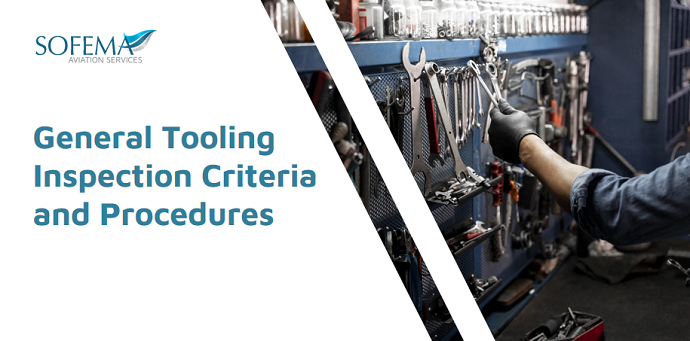Presented by Sofema Aviation Services (SAS) www.sassofia.com – Here we consider the appropriate tooling Inspection criteria for tooling which is not typically requiring Calibration Control and not covered by “Safety Inspections” applicable for example to Hoist & Harness Straps or Chains, Fuel tank Lighting, etc.
Introduction
Within the EASA Part 145 Tooling Store are contained a variety of tooling & equipment some of which is subject to the requirements of calibration control – but all of which must be inspected and maintained in a serviceable condition.
Within the Tooling Store, we should have a loan return Inspection Policy whereby a general assessment is made regarding the ongoing serviceability of the tool or equipment.
In addition, we should have a Periodic Controlled Inspection whereby all tools are inspected for conformity in detail. (For Example, the potential for spanner jaws to spay or wear)
What Inspections are Relevant for Tooling & Equipment?
- General Visual Inspection
- Conformity Inspection (Detailed Inspection)
- Electrical Power Tools Special Inspection
- Pneumatic & Hydraulic Power Tools Special Inspection
Concerning General Visual Inspection
The cleaning, inspection, and storage of the tools should be accomplished at the end of every shift or prior to returning the tool to the Tooling Store (Best Practice Tool Inspection and Control).
All Maintenance Technicians should demonstrate knowledge and hands-on skills with regard to the correct use and maintenance of all hand and power tools which are being used.
The purpose of a General inspection process is to thoroughly inspect all of the general hand tools for the following:
- Visible Damages
- Dents
- Cracks
- Other Deformities
The Following Detailed Inspection Criteria maybe incorporated into a return to Tooling Store Checklists:
Screwdriver Visual Inspection
- Handles are tight in the shank, clean, not worn or cracked, and do not show signs that the screwdrivers were used as a chisel or as a punch.
- If they are electrically insulated, insulation is fully protective.
- The shanks are straight and do not show signs the screwdrivers were used as a pry bar or submitted to extra turning power.
- The tips of the blades in slotted screwdrivers show a straight edge.
- The tips of Phillips screwdrivers have the star configuration well defined.
Hammers Visual Inspection
- No tape is wrapped around the handles.
- All handles do not show slivers or any cracks.
- The handles, if not integral, are firmly and correctly attached to the head of the hammers.
- The heads are not damaged, and the faces are not mushroomed.
Wrenches Visual Inspection
- Adjustable wrenches should not normally be used in place of fixed opening wrenches.
- The jaws of pipe wrenches are not worn to the point of not providing the necessary grip against a pipe.
- Wrenches do not present deformations caused by being abused.
Saws Visual Inspection
- The handles are firmly attached to the blades or to the frames.
- Blades are tightly attached and not dull or damaged.
Pliers Visual Inspection
- Pivot points and/or joints are firm.
- If a plier is electrically insulated insulation is fully protective.
- Pliers have not been abused (Signs of Stress or Impact Damage).
Files Visual Inspection
- Teeth are of equal height and not dull.
- Handles, if non-integral, are firmly attached to the tang.
- Files do not present any abnormality in their shapes and surfaces which could indicate that they were used as a pry bar or hammer.
- Files are dry and there is no foreign material stuck in between the teeth.
Chisels Visual Inspection
- Handles are firmly attached to the tang and not cracked if made of wood.
- No mushroomed heads.
- The cutting edges are sharp.
Utility knives Visual Inspection
- Utility knives not in use have their blade retracted.
- Handles are not damaged.
- The blades are not dull and their tips are not damaged.
Concerning Conformity Inspection (Detailed Inspection)
Periodically all tools should be formally inspected in a controlled way – Means documented & auditable.
Some companies subdivide the Internal Tool Store into 6 Zones and during a 2 month period, every tool in a particular Zone will be subjected to detailed inspection.
In this way each year every tool and item of equipment will be inspected against a Conformity Checklist.
Electrical Power Tools Special Inspection
- When not in use they should be disconnected from the energy source and properly stored.
- They do not show signs of being operated outside their designed specifications.
- The tools, besides being visually inspected, should also be briefly turned on in order to check for abnormal noises, malfunction of switches, etc.
- Electrical cords are in good condition and have a three-pronged plug or are double insulated.
- The cordless tools have compatible rechargeable batteries and chargers in good condition.
Pneumatic & Hydraulic Power Tools Special Inspection
- Hoses do not present damage or splices; their pressure ratings and diameters are adequate.
- When using quick disconnect type fittings, the male end is installed on the tool.
- ·Radiator hose clamps are not used to secure air hoses to fittings.
- ·Warning signs: maximum pressures, working loads, etc. are conspicuously displayed and easy to read.
- Hoses, couplings, fittings, and valves follow the manufacturer’s specifications and do not present any sign of damage.
Safety Note – Be Aware of the possible existence of “residual energy” even after the equipment has been shut down.
Next Steps
Follow this link to our Library to find & Download related documents for Free.
Sofema Aviation Services provides the following 1-day training course covering the essential areas of the Part 145 Tooling Store
Please see the following link or email team@sassofia.com
Part 145 Stores Tooling Control, Inspection Procedures & Best Practice – 1 Day
Tags:
aviation, EASA Part 145, EASA Part 145 Stores, SAS blogs, Part 145 Tooling Store, Aviation Tooling Store, Aircraft Tooling, Tool Store Environment, Tooling Inspection, General Tooling




